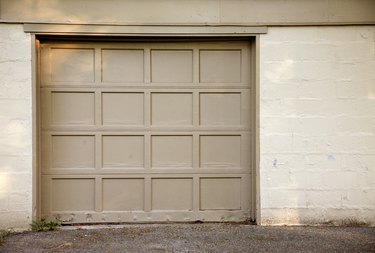
Installing drywall gives your garage a finished look and covers unsightly wiring while also providing a measure of insulation and noise reduction. Drywall installation in a garage is very similar to that of in-home installation, although you may choose not to give the walls a painted finish. Different types of drywall panels offer the homeowner different benefits, but the type of panel you choose may be dictated by local building codes.
Climate Considerations
Video of the Day
Standard drywall panels contain compressed particles of gypsum covered with thick paper. That's fine in your home, but unless you're finishing your garage as a living space, complete with insulation and a heat and air system, moisture-resistant drywall is preferable. Most garages are not climate controlled, and high levels of humidity, rain or blowing snow can damage panels unless they are moisture resistant.
Video of the Day
Drywall Panel Size
The most common drywall panel size measures 4 feet by 8 feet, and if the garage walls are 8 foot high, that's the optimal size. If the garage walls are 9 feet high, select panels that are 54 inches wide. When installed horizontally, the panels will fit evenly, eliminating the need to cut the panels. For the ceiling however, the general rule in construction is to install the largest drywall panels you can handle safely. The larger the panels, the fewer the seams, and if you're taping out the drywall, large panels will save time and labor.
Local Codes
Before installing drywall, check with your local building authority. In many communities, if an adjoining wall attaches the house to the garage the wall must meet fire code standards. Codes vary from community to community, but you may have to install fire-rated drywall in this area. In addition, the process you use to tape out the wall may have to meet fire code regulations.
Other Considerations
Hanging drywall requires upper body strength, especially for attaching the panels to the ceiling. A drywall lift is essential for elevating and holding overhead panels, leaving your hands free to install the drywall screws. For installing upper wall panels, you'll need at least two strong workers who can lift and hold the panels in place while you insert the screws.